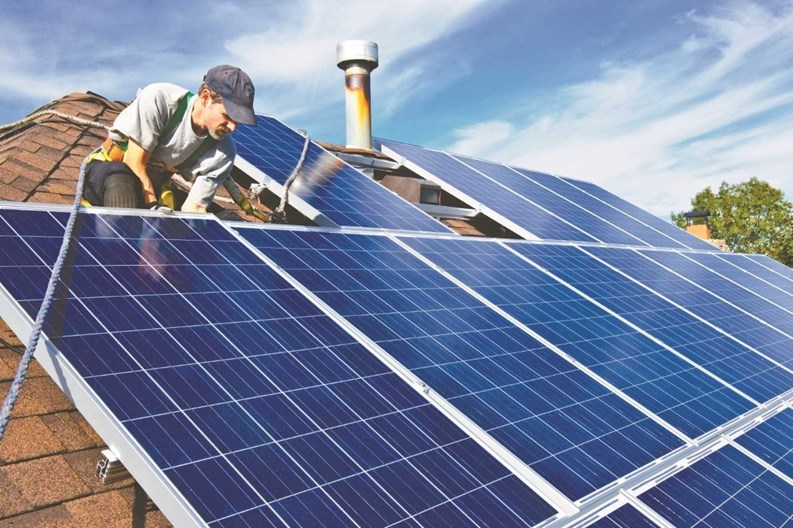There are many reasons for “going green” in a residential community, starting with the goal of shrinking the carbon footprint and decreasing dependence on fossil fuels. But the real reason a condominium complex or HOA seeks sustainable energy solutions is to save money.
Major projects such as solar panels, geothermal systems and wind turbines can take advantage of the best deal of all—free fuel. To date, however, the single biggest barrier to the installation of sustainable energy sources has always been the high upfront cost. Experts admit that for solar, photovoltaic [PV] projects, approximately 90 percent of the lifetime cost involves payments upfront, for panels and installation.
A community association that wants to cut its common-area energy costs by “going green” has a number of choices. Businesses and energy companies are evolving to meet growing demands for sustainable energy and are finding ways to bring the upfront cost down. There are solar installation firms that will install and lease the PV panels, sometimes for a low [or no] down payment, so that customers realize savings on electricity from day one. These businesses offer various buy-back and energy credits in conjunction with utility companies, and the offers differ from state to state.
Associations may also focus on tweaking or upgrading their property’s existing infrastructure rather than diving into a major, capital investment with long-term debt. As an added benefit, upgrades that reduce energy use are eligible for incentives and rebates from state and federal governments.
Look to Self-financing
Some communities, though, bypass the funding and dig into their own pockets when they decide to go down the green path. The largest solar water heating project to date in California is scheduled to be completed this summer at a 320-unit condominium community in San Jose called The Tradewinds. The rooftop system is being installed by Free Hot Water, a San Jose solar distributor and engineering firm.
As Tradewinds’ community association manager Craig Gorewitz explains, “Our gas bill, for hot water, was a big chunk of our budget. Our complex is a little unique, in that we have a [common property] master boiler system that supplies the hot water for most of the units.”
“About two years ago,” he continues, “we researched a project for installing solar water-heating thermal panels. We presented the proposal to the membership… things move slowly in a condo community, and this spring the construction finally started. To pay for the project, with members’ approval, we are borrowing from our own reserve account. We figure the system will pay for itself in less than three years. Even if it took five years, it’s still a great deal.”
Cashing In with Incentives
At the federal level, a program is currently underway in which homeowners are eligible for tax credits for qualified solar water heating and PV systems. Solar water heating systems like the one at Tradewinds involve outdoor piping—usually rooftop—to produce hot water, while photovoltaic systems produce electricity and may include solar-powered attic fans. The credits are available for systems “placed in service” at any dwelling unit, not necessarily the primary residence, between January 1, 2006 and December 31, 2016.
The Solar Energy Industries Association (SEIA), a Washington-based advocacy group, notes that tax credits go to businesses that install solar equipment for their use, and to individuals who install qualifying systems on homes they use as a residence (unlike other consumer incentives, the dwelling does not have to be the taxpayer's primary residence; second homes are eligible, although rental properties are not).
In the case of cooperative apartment buildings owned by a corporation, SEIA states that "if the corporation spends money on installing qualified solar property, each shareholder is allowed to claim residential solar tax credits on his or her share of the spending."
In the case of condominiums, SEIA reports that when the condominium management association "spends money on installing qualified solar property, each member of the association can claim the residential solar tax credits on his or her share of that spending," so long as the management association qualifies as a homeowners' association under the law, and the majority of the units in the condominium are used as dwelling units.
More detailed information regarding this legislation is available online at www.seia.org by downloading the “Guide to Federal Tax Incentives for Solar Energy.”
Looking at what utilities can offer, National Grid—an energy supply company that operates in several New England states—provides an example. For small-business customers with an average demand use of 300 kilowatts or less per month, it can help reduce energy costs by installing energy efficient equipment.
National Grid provides a free energy audit and report of recommended energy efficiency improvements. It will pay 70 percent of the installation cost of energy-efficient equipment and finance the remaining 30 percent, interest free, for up to 24 months. Cost-cutting, energy- efficient equipment available through this program includes lighting upgrades, energy efficient timeclocks, photo cells for outdoor lighting, occupancy sensors and programmable thermostats.
States and Utilities Get on Board
Starting with Massachusetts as an example, the Renewable Energy Generation division of the Massachusetts Clean Energy Center is responsible for supporting renewable energy projects throughout the commonwealth. Working in partnership with the state’s Executive Office of Energy and Environmental Affairs, MassCEC has supported more than 2,000 projects in more than 275 communities with funding from the MassCEC’s Renewable Energy Trust fund, which was created through the Electric Utility Restructuring Act of 1997, and is funded by an electric utility surcharge.
MassCEC has awarded grants to hundreds of businesses, towns, and organizations for feasibility and/or design and construction of solar panels, wind turbines, biomass systems, hydroelectric systems, and other clean energy projects.
In Connecticut, a similar program called the Energy Efficiency Fund will cover a portion of the costs of energy-saving improvements, reports David Mann, principal in Green Tek Consulting of Westport.
He says that condo and HOA communities have a real advantage for receiving energy subsidies. “They can receive subsidies and get higher rebates, as a community, because energy programs are customized according to size [of the community] and measure of the energy-savings impact that the program would have. Per resident, a condo association could get multiple the cost savings of a single family home.”
As an example, Mann cites an association in Norwalk, Connecticut. “This community had 222 units in 27 buildings plus common area structures, such as a pool and clubhouse. They wanted to go green, and with lots of room for positive improvement, their project could show a high impact [on energy savings]. They got support from New England Conservation Services and the Connecticut Energy Efficiency Fund (CEEF).”
Mann explains that utility companies in Connecticut are mandated by the state to contribute to these funds with a percentage of their receipts. “Conservation and load management are the responsibility… of these quasi-public corporations,” he notes.
Experts Offer Direction
For an association that wants to pursue energy savings, Mann outlines the process his firm would take: “We evaluate the [residential] complex to identify cost-effective weatherization solutions, secure the CEEF funding and implement a number of solutions.”
Starting with community-wide education sessions and condo units’ weatherization, improvements may include air sealing to eliminate leaks/drafts, lighting replacement (including subsidized LEDs), programmable thermostats, subsidized HVAC equipment upgrades (by rebate), subsidized timers, sensors, and efficient fans. In common areas, Green Tek might survey and analyze the complex’s existing building envelopes, and a deep energy retrofit of common facilities could cover high performance insulation, HVAC upgrades, weatherization, efficient interior and area lighting, and analysis for future implementation of renewable energy.
Mann cites the example of a complex in Connecticut that implemented this comprehensive set of services. It became a competitive advantage as a real estate marketing tool—in one board member’s appraisal for refinancing, the appraiser noted the program in his report.
As another example, John Greeno, the president and owner of New England Conservation Services, says that his company “provides an analysis of conservation and energy-saving systems for residential customers. In Connecticut, the program is geared to the electric and [natural] gas utilities.” He notes that each New England state has different criteria for their energy-saving programs; for instance, “Massachusetts is ‘fuel blind’ so home heating oil is included.”
He explains how his firm would organize a program that earns energy incentives for condo or HOA communities. “We would start by scoping out the property with a walk-through, and maybe do some work in individual units as an example.” The analysis may suggest improvements in any number of areas, such as insulation, sealing and weatherproofing, heat pumps, more efficient boilers or air conditioning, fans or exterior lighting.
“Then,” continues Greeno, “an agreement is drawn up between the association and the contractor who provides the conservation services. A representative from the utility company reviews the proposed measures, to determine cost effectiveness and figure out the incentives.
“Funding is paid in the form of incentives that ‘buy down’ the cost [to the association] of these improvements… this buy down could cover 100 percent of the project in some cases.” He adds that when homeowners participate, for improvements in their own units, a cost-sharing system may be applied that is administered by the association.
Starts with the Audit
Nik Clark, director of client services at Reserve Advisors, Inc. in Hartford, Connecticut, believes that associations need to “figure out their reserves… Where do the reserve funds fit in with any ‘green’ initiative? Upgrades… from LED lighting to solar panels, need large capital investments, so figure out the community’s reserve fund first.
“Then,” he continues, “have an energy audit—this is something many communities have not done yet. I would say, let’s troubleshoot you property first and see what we can make better, then figure out return-on-investment. Any ROI can vary greatly” because of trends and fuel price fluctuations. Clark points out that oil, gas or other fuels might drop in price after a community has spent money changing over to a system that promises eventual savings. “You might get stuck paying off a huge investment… on what might [eventually] be a fad,” he warns. “How do you know what is legitimate?”
If an association decides on investing in a system with proven cost savings and ROI, then “figure out how to fit this investment into your reserve plan,” Clark recommends.
Marie Auger is a Massachusetts-based freelance writer and a frequent contributor to New England Condominium.







Leave a Comment